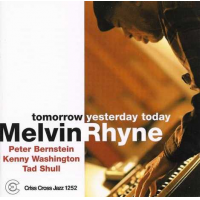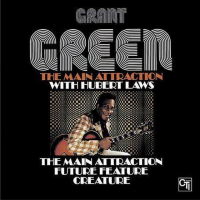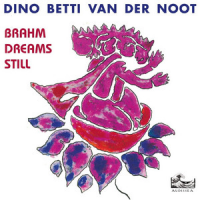Home » Jazz Articles » Liner Notes » Anthony Branker: What Place Can Be for Us? - A Suite in ...
Anthony Branker: What Place Can Be for Us? - A Suite in Ten Movements
The composite of this artistry exists within the remarkable circumference of his achievements, from conducting extended form compositions by Terence Blanchard and Duke Ellington, to Fulbright and National Endowment for the Humanities grant awards, and decades of accomplished musical scholarship and academic leadership at Princeton and currently Rutgers University. As composer, arranger, educator, scholar, conductor, and performer, Branker has traveled the world in service of blending a meticulous study of melody and rhythm, with the gravity of critical stories that have shaped his life and the world around him.
Leading three bands (Imagine, Word Play and Ascent), Branker deftly constructs his musical manifestos in pursuit of the kind of timeless recordings that make up his extensive artistic catalog. From the angular and often halting grandeur of albums like Beauty Within and Dialogic to the profound political interplay of Uppity and The Forward (Towards Equality) Suite, Branker excels at balancing structure with open forms, creating dynamic platforms encouraging collective conversation between the countless gifted musicians he collaborates with.
Beneath the choreography of such enduring melodies, complex rhythmic structures and sinuous harmonic lines is a relentlessly curious and contemplative mind. Embedded within the humble characteristics of a musician who routinely engages listeners "where they are," is an open invitation to experience beauty through the spiritual path of expanding one's social consciousness. In this unique space, music flowers through spoken-words, high-octane guitar play, kinesthetic rhythms, and a modal harmonic language flexible enough to encompass the variety of musical genres Branker molds into his compositions.
After witnessing the forced mass migration of Syrian civilians during their bloody civil war, Branker committed to composing 'What Place Can Be For Us?' as a suite of ten movements to unpack the "overarching issues of inclusion and belonging," while speaking to the "circumstances of exploitation and zones of refuge experienced by people of color and other global citizens." Simultaneously visceral and cinematic, Branker's genius resides in the tuneful craft of detailing these compositions with the depth, counterpoint and subliminal tension required to portray the solemn and stark realities of how place and belonging are defined within hostile environments.
'What Place Can Be For Us?' posits a deceptively simple question with a range of compositions that explore how slavery, xenophobia, systemic racism and cultural erasure have built and sustained a precarious fragility to our sense of place and belonging in an increasingly fractured world. Born into an immigrant family, (parents arriving to the United States from Trinidad in the mid 1950's) Branker's lived experience is a potent anchor for the album's ambition, and an agile foundation for the inquiry of his insightful musicality.
Rallying around vocalist and spoken word artist Alison Crockett, the album opens with "The Door of No Return," a composition inspired by the horrific slave trade that passed through Senegal's Gorée Island. Separated by four sub-movements, the composition's tale finds guitarist Pete McCann channeling Jimi Hendrix, as horn refrains by Philip Dizack, Remy Le Boeuf, and Walter Smith III harmonize beneath Crockett's ingenious interpretation of poetry composed by Brazilian writer Beatriz Esmer. Sundown Town's melancholy centers around the paradox Branker applies to the curious expectations of conventional listening. Elegant but somber harmonies and melodic lines speak to the white supremacist practice of banishing people of color from certain townships by sundown, while improvisations by pianist Fabian Almazan and trumpeter Philip Dizack color the song's elusive theme of self-determination.
"I, Too, Sing America" is based on Langston Hughes' poem "I, Too" that was first published in The Weary Blues in 1926. Here it takes on an entirely different dimension as Crockett and tenor saxophonist Walter Smith III breathe new fire into this legendary anthem. Insistent and angular, Indivisible is a voltaic mosaic showcasing the ways Branker's septet can seemingly speak all at once while collectively making space to support solos by unique artists like McCann and alto saxophonist Remy Le Boeuf. Inspired by the novelty of this elegant phrase, "We Went Where the Wind Took Us," is a capricious tune with exquisite solos by Almazan and bassist Linda May Han Oh.
Punctuated by turbulence, "What Place Can Be For Us?" demands the band's full attention before settling in with solos by Dizack, Smith and drummer Donald Edwards over an edgy funk groove. Inspired by 'Get Out,' Jordan Peele's benevolent horror film on racism, "Sunken Place" speaks to the systemic marginalization of people of color and women. Thematically aligned, the tension of the melody is initially displaced but then brilliantly reconstructed over several instrument registers over the course of the composition. Bound to the spiritual arc that ancestors play in all forms of struggle, "The Trail of Tears to Standing Rock" speaks to the infamous legacy of the genocidal treatment of Indigenous Americans. Dizack shines on the track, navigating the emotional terrain with a gorgeous solo that elegantly captures the sanctity of the composition.
Sticking with complex melodic lines, Branker uses "Sanctuary City" to examine the refuge extended to undocumented immigrants seeking protection from violence, poverty and xenophobia. Drummer Donald Edwards paces "Placeless," a fascinating amalgamation of mastery that points to Branker's love of fusing hard bop with the freer aspects of collective composition. As a nod to the band, and perhaps even a thank you, "Placeless" also demonstrates the high level of mastery required to play Branker's music with such fluidity and conviction.
Deconstructing the world in this manner is like taking a hammer to a house of mirrors. Branker constantly reminds us that while we might not like what we see, there's always room for change, and always strength in answering questions with songs you can hum, dance to, and reorient your world view around. Such explorations require faith in the resilience of beauty—a hinge that swings freely within the glorious music of What Place Can Be For Us? A Suite in Ten Movements.
Profound answers to important questions require music that distills rigor, purpose and story into a renewed sense of place. Anthony Branker's place in Jazz has been consistently building unique architectures that speak to the cultural reparation of allowing this art form to thrive as protest music. What Place Can Be For Us? A Suite in Ten Movements is much more than just another stunningly good album from a vastly under-recognized artist; it's music that seeps into the pores of your consciousness, music that rightfully hurts before its beauty and rectitude fortifies a new agenda for your heart.
Liner Notes copyright © 2026 Michael Ambrosino.
What Place Can Be for Us? - A Suite in Ten Movements can be purchased here.
Contact Michael Ambrosino at All About Jazz.
Exploring Jazz one essay / show / feature / documentary at a time.
Track Listing
The Door of No Return; Sundown Town; I, Too, Sing America; Indivisible; We Went Where the Wind Took Us; What Place Can Be For Us?; Sunken Place; The Trail of Tears to Standing Rock; Sanctuary City; Placeless.
Personnel
Anthony Branker
composer / conductorWalter Smith III
saxophone, tenorPhilip Dizack
trumpetRemy Le Boeuf
flutePete McCann
guitarFabian Almazan
pianoLinda May Han Oh
bass, acousticDonald Edwards
drumsAlison Crockett
vocalsAlbum information
Title: What Place Can Be for Us? - A Suite in Ten Movements | Year Released: 2023 | Record Label: Origin Records
Tags
About Anthony Branker
Instrument: Composer / conductor
PREVIOUS / NEXT
Support All About Jazz
 All About Jazz has been a pillar of jazz since 1995, championing it as an art form and, more importantly, supporting the musicians who make it. Our enduring commitment has made "AAJ" one of the most culturally important websites of its kind, read by hundreds of thousands of fans, musicians and industry figures every month.
All About Jazz has been a pillar of jazz since 1995, championing it as an art form and, more importantly, supporting the musicians who make it. Our enduring commitment has made "AAJ" one of the most culturally important websites of its kind, read by hundreds of thousands of fans, musicians and industry figures every month.





























